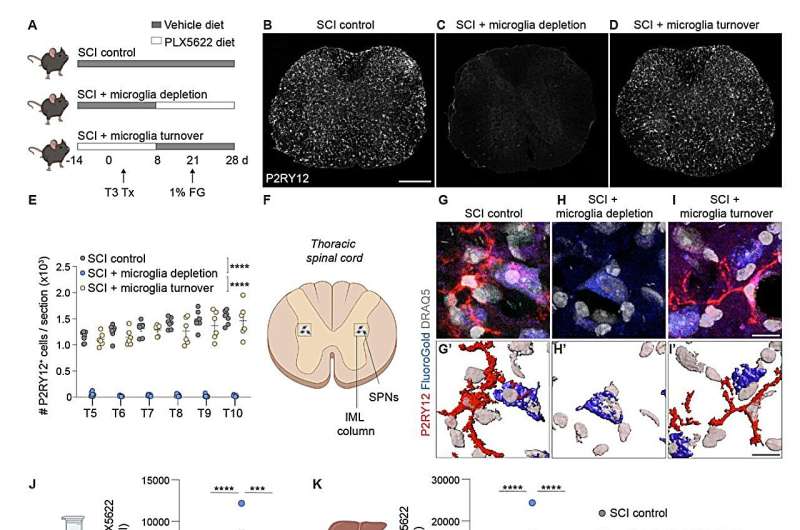This article has been reviewed according to Science X's editorial process and policies. Editors have highlighted the following attributes while ensuring the content's credibility:
fact-checked
peer-reviewed publication
trusted source
proofread
Mouse study identifies unique approach for preventing life-threatening complications after spinal cord injury

In response to stressful or dangerous stimuli, nerve cells in the spinal cord activate involuntary, autonomic reflexes often referred to as "fight or flight" responses. These protective responses cause changes in blood pressure and the release of stress hormones into the blood stream. Normally, these responses are short-lived and well-controlled, but this changes after a traumatic spinal cord injury.
A first-ever study published in the journal Science Translational Research identifies a druggable cellular target that, if controlled properly, could prevent or lessen autonomic dysfunction and improve quality of life for people with spinal cord injury.
"We discovered that exaggerated, life-threatening autonomic reflexes after spinal cord injury are associated with abnormal growth and rewiring of nerve fibers in the spinal cord. A specific cell type, called microglia, controls this abnormal growth and rewiring," said corresponding author Phillip Popovich, Ph.D., professor and chair of the department of neuroscience at The Ohio State University Wexner Medical Center and College of Medicine.
"Using experimental tools to deplete microglia, we found it's possible to prevent abnormal nerve growth, and prevent autonomic complications after spinal cord injury," said Popovich, who also is executive director of Ohio State's Belford Center for Spinal Cord Injury.
This research used a mouse model of spinal cord injury. However, abnormal, potentially life-threatening autonomic reflexes also occur in other animals and in people with spinal cord injury, said Popovich, who is also a member of Ohio State's Institute for Behavioral Research Medicine.
Autonomic dysfunction or "dysautonomia," is a major problem for people living with spinal cord injuries.
In people and animals with spinal cord injury, normally harmless stimuli, such as a full bladder, can suppress the body's immune system and cause uncontrolled changes in blood pressure.
This leads to life threatening complications including heart attack, stroke, metabolic disease and severe infections, like pneumonia.
There is currently no treatment that prevents dysautonomia.
"We consider this a major finding," said first author Faith Brennan, Ph.D., who began this work at Ohio State and is now a neuroscience researcher at Queen's University in Kingston, Ontario. "Although this is a well-known consequence of spinal cord injury, research has mostly focused on how the injury affects neurons that control autonomic function."
Improving autonomic function is a top priority for people living with spinal cord injury. Limiting the effects of dysautonomia after spinal cord injury would significantly increase quality of life and life expectancy, Popovich said.
Next steps for this research will focus on identifying the specific neuron-derived signals that control microglia, causing them to remodel spinal autonomic circuitry.
"Identifying these mechanisms could lead to the design of new, highly specific therapies to treat dysautonomia after spinal cord injury. It could also help in other neurological complications where dysautonomia develops, including multiple sclerosis, Alzheimer's disease, Parkinson's disease, stroke and traumatic brain injury," Popovich said.
More information: Faith H. Brennan et al, Microglia promote maladaptive plasticity in autonomic circuitry after spinal cord injury in mice, Science Translational Medicine (2024). DOI: 10.1126/scitranslmed.adi3259



















